 True Believers: Phoenix Presents Cyclops and Marvel Girl #1 (of 1) — Writer: Arnold Drake; Pencils: Don Heck and Werner Roth; Inks: John Verpoorten
True Believers: Phoenix Presents Cyclops and Marvel Girl #1 (of 1) — Writer: Arnold Drake; Pencils: Don Heck and Werner Roth; Inks: John Verpoorten
True Believers: Enter…the Phoenix! #1 (of 1) — Writer: Chris Claremont; Art: Dave Cockrum
Astonishing X-Men #6 — Writer: Charles Soule; Art: Mike del Mundo; Colors: del Mundo and Marco D’Alfonso
X-Men Gold #17 — Writer: Marc Guggenheim; Art: Ken 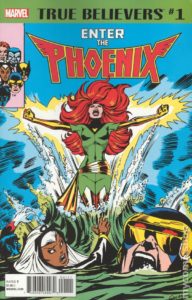 Lashley; Colors: Juan Fernandez
Lashley; Colors: Juan Fernandez
If there was any doubt that Marvel was about to resurrect Jean Grey (who’s been “dead” since Grant Morrison killed her back in 2003), look to the two one-dollar “True Believer” reprints out this week, both Phoenix-related: Cyclops and Marvel Girl is a reprint of the original X-Men #48, the first solo story of those two star-crossed lovers; there’s also a five-page origin of Marvel Girl from the same period; it’s a colorful, utterly average example of late-’60s Marvel superhero comics, but since those were better than 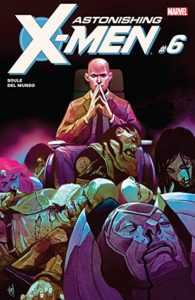 anyone else’s similar fare, it’s worth the buck. Even more so for “Enter… the Phoenix!” and its reprint of the last few pages of X-Men #100 and all of #101, where Jean first becomes the Phoenix and Claremont kicks the soap-opera, characterization-defining subplots surrounding the team into a high gear that, with the arrival of John Byrne with the next year, will make it the best-selling American comic for the next two decades. That’s worth a buck, too. Of the current X-titles, Astonishing X-Men #6 has been featuring the astral spirit of Charles Xavier (trapped by the Shadow
anyone else’s similar fare, it’s worth the buck. Even more so for “Enter… the Phoenix!” and its reprint of the last few pages of X-Men #100 and all of #101, where Jean first becomes the Phoenix and Claremont kicks the soap-opera, characterization-defining subplots surrounding the team into a high gear that, with the arrival of John Byrne with the next year, will make it the best-selling American comic for the next two decades. That’s worth a buck, too. Of the current X-titles, Astonishing X-Men #6 has been featuring the astral spirit of Charles Xavier (trapped by the Shadow  King lo, these many months), and resolves its first volume by bringing him back, but in an unexpected way; it’s been deliberately mining the Claremont-era team tropes since it started, and well, and del Mundo’s Day-Glo colors and hallucinatory effects enhance both the astral and the real-world scenes. X-Men Gold has been working a similar spell, with similar retro elements, on its version of the team, and offers the second chapter of a “Negative Zone War” arc that sees Kitty and Nightcrawler inadvertently kidnapped by aliens from that antimatter region, and everybody else marshaling forces to track them down and bring them back; the creators’ affectionate, knowledgable grasp of the characters plays to older fans, and makes it easy to like.
King lo, these many months), and resolves its first volume by bringing him back, but in an unexpected way; it’s been deliberately mining the Claremont-era team tropes since it started, and well, and del Mundo’s Day-Glo colors and hallucinatory effects enhance both the astral and the real-world scenes. X-Men Gold has been working a similar spell, with similar retro elements, on its version of the team, and offers the second chapter of a “Negative Zone War” arc that sees Kitty and Nightcrawler inadvertently kidnapped by aliens from that antimatter region, and everybody else marshaling forces to track them down and bring them back; the creators’ affectionate, knowledgable grasp of the characters plays to older fans, and makes it easy to like.
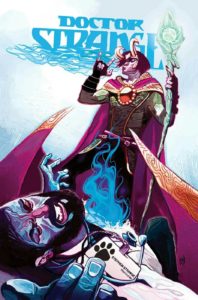 Doctor Strange #382 — Writer: Donny Cates; Art: Gabriel Hernandez Walta; Colors: Jordie Bellaire
Doctor Strange #382 — Writer: Donny Cates; Art: Gabriel Hernandez Walta; Colors: Jordie Bellaire
Captain America #696 — Writer: Mark Waid; Art: Chris Samnee; Colors: Matthew Wilson
Avengers #674 — Writer: Mark Waid; Art/Colors: Jesus Saiz
Hawkeye #13 — Writer: Kelly Thompson; Art: Leonardo  Romero; Colors: Jordie Bellaire
Romero; Colors: Jordie Bellaire
Spider- Man #235 — Writer: Brian Michael Bendis; Art: Oscar Bazaldua; Colors: Brian Reber
Doctor Strange continues a fun relaunch that began with Loki as the Sorcerer Supreme and Strange working in a veterinary clinic with a talking dog, and is filling us in about just how that happened as it races along; Walta’s art  makes everyone look weirdly attractive, something like Frank Quitely’s, and Cates does a good job of making the two rival magicians complicated, sympathetic characters. Mark Waid and Chris Samnee have started their Captain America run with a series of self-contained, one-issue tales that harken back to the ’60s Cap and his tendency to hop on a motorcycle and take off to discover America. This episode, which involves the Swordsman, is a glittering example of expert storytelling, without a panel of wasted
makes everyone look weirdly attractive, something like Frank Quitely’s, and Cates does a good job of making the two rival magicians complicated, sympathetic characters. Mark Waid and Chris Samnee have started their Captain America run with a series of self-contained, one-issue tales that harken back to the ’60s Cap and his tendency to hop on a motorcycle and take off to discover America. This episode, which involves the Swordsman, is a glittering example of expert storytelling, without a panel of wasted 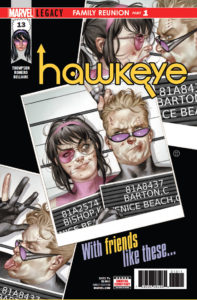 space; only Warren Ellis matches Waid’s ability to craft efficient, complete one-off stories like this. Avengers #674 shows Waid at the longer end of the storytelling spectrum, with Chapter Five of a six-part crossover with The Champions, as they try to keep the High Evolutionary from smashing Counter-Earth into Earth and ruining everyone’s day; as must happen in these events, there’s a heroic sacrifice, but, Waid being Waid, it goes off in an unexpected direction at the end, avoiding maudlin cliche in favor of cool intellectual curiosity. Hawkeye sees the LA reunion of Clint and Kate,
space; only Warren Ellis matches Waid’s ability to craft efficient, complete one-off stories like this. Avengers #674 shows Waid at the longer end of the storytelling spectrum, with Chapter Five of a six-part crossover with The Champions, as they try to keep the High Evolutionary from smashing Counter-Earth into Earth and ruining everyone’s day; as must happen in these events, there’s a heroic sacrifice, but, Waid being Waid, it goes off in an unexpected direction at the end, avoiding maudlin cliche in favor of cool intellectual curiosity. Hawkeye sees the LA reunion of Clint and Kate,  whose platonic, affectionate bickering and semi-serious rivalry propel the narrative; I think it’s also the first book to name-check any of the characters’ time-traveling “Generations” encounter as being in continuity — with Clint’s befuddled reaction to the memory a good example of writer Thompson’s insight into his personality. Spider-Man sees Miles Morales and friends dealing with a new version of the Sinister Six with a couple of family connections; it’s slickly, confidently told; it’ll be interesting to see how Bendis wraps up his signature Marvel book, one he’s been writing in one form or another for almost two decades, before he leaves in a couple of months.
whose platonic, affectionate bickering and semi-serious rivalry propel the narrative; I think it’s also the first book to name-check any of the characters’ time-traveling “Generations” encounter as being in continuity — with Clint’s befuddled reaction to the memory a good example of writer Thompson’s insight into his personality. Spider-Man sees Miles Morales and friends dealing with a new version of the Sinister Six with a couple of family connections; it’s slickly, confidently told; it’ll be interesting to see how Bendis wraps up his signature Marvel book, one he’s been writing in one form or another for almost two decades, before he leaves in a couple of months.
 Batman #36 — Writer: Tom King; Pencils: Clay Mann; Inks: Clay Mann and Seth Mann; Colors: Jordie Bellaire
Batman #36 — Writer: Tom King; Pencils: Clay Mann; Inks: Clay Mann and Seth Mann; Colors: Jordie Bellaire
The Shadow/Batman #3 (of 6) — Writer: Steve Orlando; Art: Giovanni Timpano; Colors: Flavio Inspenza
Batman/Teenage Mutant Ninja Turtles II #1 (of 6) — Writer: James Tynion IV; Art: Freddie Williams II; Colors: Jeremy Colwell
Batman: White Knight #3 (of 8) — Writer/Artist: Sean Murphy; Colors: Matt Hollingsworth
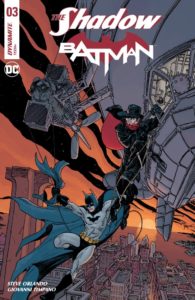 Harley and Ivy Meet Betty and Veronica #3 (of 6) — Writers: Paul Dini and Marc Andreyko; Art: Laura Braga and Adriana Melo; Colors: Arif Prianto
Harley and Ivy Meet Betty and Veronica #3 (of 6) — Writers: Paul Dini and Marc Andreyko; Art: Laura Braga and Adriana Melo; Colors: Arif Prianto
Lots of bat-books this week (DC evidently knows he’s their best-selling character…), with the regular Batman title at the top: all that happens is that Batman/Catwoman decide to get together with Superman/Lois for dinner, but if you think that’s boring, you haven’t been paying attention to Tom King. At this point, he’s just showing off, with an actual supervillain plot in the deep background, and a split-screen narrative following  Clark/Lois and Bruce/Selina as they each debate their World’s Finest relationship; it’s clever, fun, touching and amusing in all the right places. Batman/Shadow has those two leads fighting Shadow nemesis Shiwan Khan; it’s a sequel to their first mini-series earlier this year, and has an effective, Sixth Sense-like cliffhanger that should bring readers back. Batman/Teenage Mutant Ninja Turtles is a sequel, too (to the first Bat/TMNT series and its regular-DC, in-continuity cast, not the subsequent TV-cartoon “Adventures” one), and involves a Lazarus Pit-activated Bane crossing dimensions and hooking up with the Foot Clan; if you enjoyed the first series (and a lot of
Clark/Lois and Bruce/Selina as they each debate their World’s Finest relationship; it’s clever, fun, touching and amusing in all the right places. Batman/Shadow has those two leads fighting Shadow nemesis Shiwan Khan; it’s a sequel to their first mini-series earlier this year, and has an effective, Sixth Sense-like cliffhanger that should bring readers back. Batman/Teenage Mutant Ninja Turtles is a sequel, too (to the first Bat/TMNT series and its regular-DC, in-continuity cast, not the subsequent TV-cartoon “Adventures” one), and involves a Lazarus Pit-activated Bane crossing dimensions and hooking up with the Foot Clan; if you enjoyed the first series (and a lot of 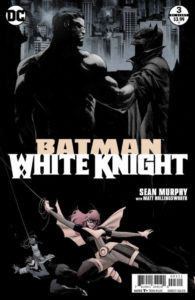 people did; it was an unexpected, sell-out hit), then this is a worthy successor to it. Batman: White Knight has gotten some heat, too, with its intricate, atmospheric Sean Miller art and script about an on-his-meds, no-longer-crazy Joker (now calling himself Jack Napier) battling the Dark Knight in the court of public opinion… and, so far, winning; it’s also got an answer to why Harley Quinn seems to have had two distinct costumes and personalities: because she’s actually two different people, an original and the more updated, Suicide Squad one, and it’s the original who isn’t at all happy about the former Joker’s “rehabilitation,” and so decides to do something about it. I can’t see any way this is actually in continuity, but it’s good-looking, fast-paced, and
people did; it was an unexpected, sell-out hit), then this is a worthy successor to it. Batman: White Knight has gotten some heat, too, with its intricate, atmospheric Sean Miller art and script about an on-his-meds, no-longer-crazy Joker (now calling himself Jack Napier) battling the Dark Knight in the court of public opinion… and, so far, winning; it’s also got an answer to why Harley Quinn seems to have had two distinct costumes and personalities: because she’s actually two different people, an original and the more updated, Suicide Squad one, and it’s the original who isn’t at all happy about the former Joker’s “rehabilitation,” and so decides to do something about it. I can’t see any way this is actually in continuity, but it’s good-looking, fast-paced, and  has a bunch of Batman Rogue’s Gallery bad guys, all good reasons to see what the fuss is about. Harley and Ivy Meet Betty and Veronica certainly isn’t in continuity (Gotham City and Riverdale – at least the homespun comics version — don’t exist in the same universe, let alone the same country), and doesn’t strictly involve Batman himself, but the two Gotham Girls give it a place on this list. It’s undeniably fun, too, thanks to the Dini/Andreyko script that currently has the titular duos having switched bodies, with Harley and Pamela trying to pass as regular high-school students and a transformed Betty and Veronica being chased through Gotham by both the cops and the bad guys: c’mon, how could you not want to see what happens next?
has a bunch of Batman Rogue’s Gallery bad guys, all good reasons to see what the fuss is about. Harley and Ivy Meet Betty and Veronica certainly isn’t in continuity (Gotham City and Riverdale – at least the homespun comics version — don’t exist in the same universe, let alone the same country), and doesn’t strictly involve Batman himself, but the two Gotham Girls give it a place on this list. It’s undeniably fun, too, thanks to the Dini/Andreyko script that currently has the titular duos having switched bodies, with Harley and Pamela trying to pass as regular high-school students and a transformed Betty and Veronica being chased through Gotham by both the cops and the bad guys: c’mon, how could you not want to see what happens next?
 DC Holiday Special 2017 — Creators: Various
DC Holiday Special 2017 — Creators: Various
Deadman #2 (of 6) — Writer/Artist/Colors: Neal Adams
Black Lightning: Cold Dead Hands #2 (of 6) — Writer: Tony Isabella; Art: Clayton Henry; Colors: Pete Pantazis
The DC Holiday Special is $9.99, but, like any stocking, is stuffed with 80 pages of goodies; a framing sequence by Jeff Lemire, Giuseppe Camuncoli and Cam Smith about John Constantine and Clark Kent in Bibbo’s bar on Christmas Eve wraps around these holiday-themed treats: a Denny O’Neil/Steve Epting Batman story; a Mairghread Scott/Phil Hester/Ande Parks Green Arrow/Black Canary one; a Tom King/Francesco Francovilla Sgt. Rock and Easy Company offering that, other  than being set in winter, has little to do with Noel but is still the star of the show; a Joshua Williamson/Neil Googe Flash fable; a Christopher Priest/Tom Grummett/Scott Hanna Deathstroke tale; A Dan Didio/Matthew Clark/Sean Parsons Atomic Knights future-set story; a Shea Fontana/Otto Schmidt Teen Titans one; a Swamp Thing story by Scott Bryan Wilson and Nic Klein; a Wonder Woman/Batman team-up by Greg Rucka and Bilquis Everly that’s runner-up for best in show; and, as a bonus, a reprint of the Mike Friedrich/Neal Adams/Dick Giordano “The Silent Night of the Batman” from 1969’s Batman #219, a Silver Age Christmas-themed story that stood out back then for its sophistication and then-startling, brand-new Adams art. His art still stands out, almost 50 years later, as Deadman #2 proves; his writing’s always been off-kilter, with Kirby-like tics and weird phrasing, and this issue proves that, too, with a Phantom Stranger who acts and talks, well, stranger than he ever has before, as do a couple of other guest-stars,
than being set in winter, has little to do with Noel but is still the star of the show; a Joshua Williamson/Neil Googe Flash fable; a Christopher Priest/Tom Grummett/Scott Hanna Deathstroke tale; A Dan Didio/Matthew Clark/Sean Parsons Atomic Knights future-set story; a Shea Fontana/Otto Schmidt Teen Titans one; a Swamp Thing story by Scott Bryan Wilson and Nic Klein; a Wonder Woman/Batman team-up by Greg Rucka and Bilquis Everly that’s runner-up for best in show; and, as a bonus, a reprint of the Mike Friedrich/Neal Adams/Dick Giordano “The Silent Night of the Batman” from 1969’s Batman #219, a Silver Age Christmas-themed story that stood out back then for its sophistication and then-startling, brand-new Adams art. His art still stands out, almost 50 years later, as Deadman #2 proves; his writing’s always been off-kilter, with Kirby-like tics and weird phrasing, and this issue proves that, too, with a Phantom Stranger who acts and talks, well, stranger than he ever has before, as do a couple of other guest-stars, 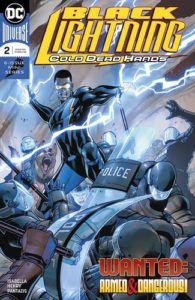 like the Spectre and the Demon. Really pretty art, though…Last up is Black Lightning: Cold Dead Hands #2; that character’s creator, Tony Isabella, is having a long-delayed moment in the spotlight now, with Jefferson Pierce’s costumed alter ego set to debut in his own series on the CW, part of its DC/Arrowverse/Flash/Supergirl programming. Isabella was never a flashy Bronze Age writer, either in his Marvel or DC work, but his stories were always very solidly constructed, and had heart; that’s still true today, and so far this is an energetic, easy-to-like mini-series that doesn’t shy away from themes of police/African-American confrontation — but, in Isabella’s script, all sides get a fair hearing, and characterization counts more than theme-pushing: a lesson more writers could stand to learn.
like the Spectre and the Demon. Really pretty art, though…Last up is Black Lightning: Cold Dead Hands #2; that character’s creator, Tony Isabella, is having a long-delayed moment in the spotlight now, with Jefferson Pierce’s costumed alter ego set to debut in his own series on the CW, part of its DC/Arrowverse/Flash/Supergirl programming. Isabella was never a flashy Bronze Age writer, either in his Marvel or DC work, but his stories were always very solidly constructed, and had heart; that’s still true today, and so far this is an energetic, easy-to-like mini-series that doesn’t shy away from themes of police/African-American confrontation — but, in Isabella’s script, all sides get a fair hearing, and characterization counts more than theme-pushing: a lesson more writers could stand to learn.
 Barbarella #1 — Writer: Mike Carey; Art: Kenan Yarar; Colors: Mohan
Barbarella #1 — Writer: Mike Carey; Art: Kenan Yarar; Colors: Mohan
Sleepless #1 — Writer: Sarah Vaughan; Art: Leila del Duca; Colors: Alissa Sallah
Klaus and the Crisis in Xmasville #1 (of 1) — Writer: Grant Morrison; Art/Colors: Dan Mora
Witchblade #1 — Writer: Caitlin Kittredge; Art: Roberta Ingranata; Colors: Bryan Valenza
Barbarella is one of those properties — ’60s hot space babe, equal parts women’s lib, sexual exploitation and sf 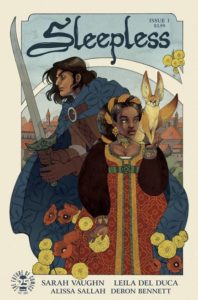 action — that can be either cool or cringe-worthy, based on its storytelling; fortunately, Dynamite’s tapped Mike Carey (Lucifer, Unwritten), who’s always had an aptitude for complicated, powerful and mythic characters, as scripter, and he jumps right in here, with our heroine stranded on a puritanical, church-ruled planet with very Handmaid’s Tale-ish ideas about women and their place in society. The book earns its “mature” rating, but there’s enough social satire and sophisticated ideas to elevate it above mere titillation, and Kenen Yarar’s got a slightly-warped, European sensibility that wouldn’t make this out of place as a serial in an old run of 2000 AD: all reason enough to give it a try. Sleepless is all the way in the other genre direction, as its cover indicates: a knights-and-damsels tale with fantasy overtones, with a king dead, his brother on the throne, and his illegitimate
action — that can be either cool or cringe-worthy, based on its storytelling; fortunately, Dynamite’s tapped Mike Carey (Lucifer, Unwritten), who’s always had an aptitude for complicated, powerful and mythic characters, as scripter, and he jumps right in here, with our heroine stranded on a puritanical, church-ruled planet with very Handmaid’s Tale-ish ideas about women and their place in society. The book earns its “mature” rating, but there’s enough social satire and sophisticated ideas to elevate it above mere titillation, and Kenen Yarar’s got a slightly-warped, European sensibility that wouldn’t make this out of place as a serial in an old run of 2000 AD: all reason enough to give it a try. Sleepless is all the way in the other genre direction, as its cover indicates: a knights-and-damsels tale with fantasy overtones, with a king dead, his brother on the throne, and his illegitimate 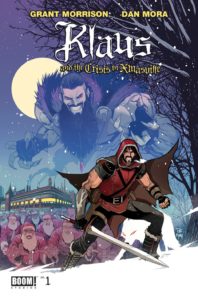 daughter the viewpoint character (along with her chaste knight/protector and friend). The all-female creative team blends both traditional and modern elements; Leila del Duca’s art, with its attractive, expression-rich faces and ability to place all the elements just so on the page, calls to mind both Joelle Jones and Fiona Staples, and if you like a combo of court intrigue and dreamy fantasy, with a little magic and otherworldly creatures on the side, then this might work for you. Klaus and the Crisis in Xmasville is the return of Grant Morrison’s “Santa Claus as fantasy warrior” meme, with an epic modern-day good-vs.-evil tale intertwined with dark alternate universes, the corruption of commercialization, kidnapped kids and mythic avatars — the standard Morrison playbook, then, and all the better
daughter the viewpoint character (along with her chaste knight/protector and friend). The all-female creative team blends both traditional and modern elements; Leila del Duca’s art, with its attractive, expression-rich faces and ability to place all the elements just so on the page, calls to mind both Joelle Jones and Fiona Staples, and if you like a combo of court intrigue and dreamy fantasy, with a little magic and otherworldly creatures on the side, then this might work for you. Klaus and the Crisis in Xmasville is the return of Grant Morrison’s “Santa Claus as fantasy warrior” meme, with an epic modern-day good-vs.-evil tale intertwined with dark alternate universes, the corruption of commercialization, kidnapped kids and mythic avatars — the standard Morrison playbook, then, and all the better 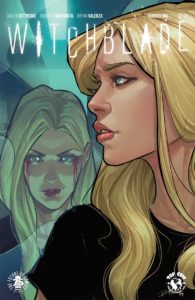 because it’s presented in a double-sized, done-in-one comic, a season-appropriate, slightly-subversive stocking stuffer. Witchblade, a reboot of that ’90s Image character (and minor TV star), sees a young woman in the NYC DA’s Witness Aid office get shot and killed by the abusive husband of a client she’s trying to protect — but then, she wakes up with the Artifact on her arm, and we’re off; it’s a new lead character for the title, and this first issue is mostly setup and foreshadowing, but it ends with action, and, like Barbarella, it’s got a female creative team taking over a property originally created by horny young men, and remaking it into a deeper, more nuanced and less exploitive comic.
because it’s presented in a double-sized, done-in-one comic, a season-appropriate, slightly-subversive stocking stuffer. Witchblade, a reboot of that ’90s Image character (and minor TV star), sees a young woman in the NYC DA’s Witness Aid office get shot and killed by the abusive husband of a client she’s trying to protect — but then, she wakes up with the Artifact on her arm, and we’re off; it’s a new lead character for the title, and this first issue is mostly setup and foreshadowing, but it ends with action, and, like Barbarella, it’s got a female creative team taking over a property originally created by horny young men, and remaking it into a deeper, more nuanced and less exploitive comic.
 Stray Bullets: Sunshine and Roses #30 — Creator: David Lapham
Stray Bullets: Sunshine and Roses #30 — Creator: David Lapham
Usagi Yojimbo #164 — Creator: Stan Sakai
Love and Rockets #4 — Creators: Gilbert and Jaime Hernandez
We’re into the “books that have been around for decades, so if you don’t know about them by now, what can I do?” section. Stray Bullets is a “Beth’s dream” issue, so it  involves high-school (well, reform school) versions of all the principles, plus a principal who’s a familiar character, plus a subconscious clue or two for when we get back to the actual main story next issue. Usagi Yojimbo, in the middle of a three-part story about murder, guest-starring Inspector Ishida, is as clearly told and wonderful as ever, while Love and Rockets offers dual flashbacks: one’s by Gilbert to Palomar in the old days, with a wrap-
involves high-school (well, reform school) versions of all the principles, plus a principal who’s a familiar character, plus a subconscious clue or two for when we get back to the actual main story next issue. Usagi Yojimbo, in the middle of a three-part story about murder, guest-starring Inspector Ishida, is as clearly told and wonderful as ever, while Love and Rockets offers dual flashbacks: one’s by Gilbert to Palomar in the old days, with a wrap- around present-day plot featuring Pipo, Fritz, Luba and a hometown funeral. Jaime’s goes back to Hoppers in the ’80s, with young-punk versions of Maggie and Hopey, and has its own present-day coda. If, like the Hernandez brothers, you were in your 20s when those stories first came out, and are considerably older now… well, Jaime and Gilbert know that score; they’ve been aging their characters as their own selves have done the same, making these fictional people and places their literal lives’ work. After all these years, every new story, every twinge of rueful nostalgia or shot of redemption, is a gift.
around present-day plot featuring Pipo, Fritz, Luba and a hometown funeral. Jaime’s goes back to Hoppers in the ’80s, with young-punk versions of Maggie and Hopey, and has its own present-day coda. If, like the Hernandez brothers, you were in your 20s when those stories first came out, and are considerably older now… well, Jaime and Gilbert know that score; they’ve been aging their characters as their own selves have done the same, making these fictional people and places their literal lives’ work. After all these years, every new story, every twinge of rueful nostalgia or shot of redemption, is a gift.



